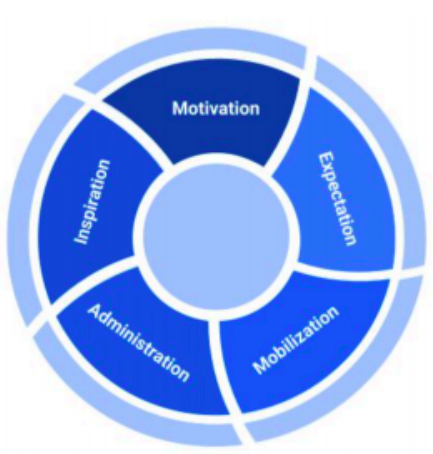I have had the privilege of building and leading teams inside many organizational cultures. As such, I have observed the varying degrees of effectiveness of many types of cultures - hierarchical, flat, inclusive, fear-inducing, supportive, toxic, and just about every combination of the above. By maintaining attention to the core principles and responsibilities that I sketched out early in my leadership career, I’ve ensured that, regardless of the broader culture, my personal mission and service to my team remains in focus. I would like to share some ideas from those core principles of servant leadership - five essential elements to consider prioritizing in your work with your team.
Early in my management career, I laid out a framework establishing what I believed were my true responsibilities regarding the building and leadership of a high-performing team. It has served me well as a personal reference for driving business results while developing and maintaining effective and meaningful relationships with most of my direct reports.
Specifically, I focus on my commitments to each individual reporting to me and the assistance I provide to help them maximize their potential. This in turn expands the potential of the entire organization.
[ Want more advice from Doug Allen? Read also: How to drive digital transformation via technology Centers of Excellence (COE). ]
Servant leadership: 5 components with real benefits
Although servant leadership is not a brand new idea, I have found that documenting these essentials, sharing them, and evolving them has driven countless beneficial conversations. I daresay it has also helped many individuals begin or accelerate successful careers.

Let’s explore the components and benefits to both managers and direct reports.
I break this down into five main areas, in no particular order of importance: Motivation, Expectation, Administration, Mobilization, and Inspiration. (Please forgive the rhyming, I was listening to a lot of Eminem and just beginning my Bob Dylan phase when these were initially crafted).
1. Motivation
Understanding employees’ motivation helps the manager understand what drives their team members to contribute to the organization. And what makes them want to contribute more. It helps the manager prepare to respond to each employee’s desire for purpose in their work. It gives the manager insight into what obstacles they are going to need to help this employee overcome - both organizationally and personally.
For employees, a manager who cares about their motivation helps them think about what makes them want to exchange part of their life to contribute to the organization. They can consider whether they are truly committed to producing the results required and if they can personally define what success looks like in this role.
2. Expectation
Setting expectations is quite simply clearly defining what is needed from each individual in the performance of their assigned role. It is all of the what’s and when’s of the position. In some roles and organizations, it may also articulate the how’s. Expectations define the goals, activities, and behaviors that drive the measurable results that the manager is charged with.
For employees, it clarifies their contribution to the organization - both what it is and what it should be. It represents the outcomes to which they are being held accountable and enables them to check the objective behaviors or metrics to which they are held accountable.
[ Is toxic leadership taking you down? Read also: How to deal with a toxic boss: 7 tips. ]
3. Administration
The administration function is perhaps the least-liked by all parties. It involves the seemingly never ending paperwork, policies, and occasionally preposterous political posturing required of any enterprise involving more than two human beings. But it is necessary.
As I far too often quote from Tom Clancy’s novel “Debt of Honor” - “If you didn’t write it down, it never happened.” The administration function enables managers to accurately and objectively assess the performance of their directs.
Even though the draconian “rank and yank” management systems of yesteryear have largely proven to be ineffective drivers of organizational performance and unmitigated destroyers of morale, a manager needs some ability to (often extemporaneously) rank their team according to skills, results, behaviors, etc. Details about individual performance have to be documented somehow.
Administration provides the manager the ability to demonstrate their team’s contributions to upline management and leaves a record for future team leaders. Team members need a means to record their contributions to the organization and some basic understanding of how their performance compares to their peers.
4. Mobilization
Mobilization is about skills and the effective application of those skills to drive the team’s mission. Managers have to ensure that their team is both equipped and deployed to most effectively contribute to the organization. This includes matching team members’ strengths with specific tasks or roles and constantly asking if there are other or alternative contributions that could be made.
The most effective managers hold their directs responsible for skills development by setting a vision for what is needed, suggesting methods, and making opportunities available. The education or “skilling up” responsibility falls on the individual.
Employees, in turn, are constantly asking if they have the skills and tools necessary to contribute to the success of the organization and themselves. It also helps them reflect on how well they are using their strengths to excel in their current role.
[ What are the characteristics of a transformational leader? Read also: What is transformational leadership? 5 qualities. ]
5. Inspiration
Inspiration is about the future. It suggests that the manager bears some responsibility for helping their directs evaluate how they can potentially contribute to other current and future needs of the organization. It makes the manager an advisor in their employees’ career planning. It typically invokes a stream of rhetorical leading questions such as, “What do you want to do next?”; “What positions do you see others performing that you might be interested in exploring?”; and “How can I help you get to your next role?”
Many organizations might frown on this, but the manager who is truly interested in inspiring the individual will include a discussion of roles both within and without their current organization, company, etc. The best next step for someone’s career may very well be somewhere else. The manager truly interested in helping people succeed should acknowledge this possibility. Similar to Mobilization, the manager’s responsibility in this arena is to coach, guide, and advocate.
The heavy lifting is the responsibility of the employee. Employees need to consider both the tactical and strategic aspects of their career - “what do I want to do next?” and “where do I see this career taking me?”
So what about the center?
The graphic of the five elements, shown earlier in the story, demonstrates how all of these elements contribute to a well rounded relationship between the manager and each of their direct reports. But as you can see, the center is open.
That is for your own mantra, ideal, virtue, pithy platitude, or other lofty thought that represents your personal management mission.
For me, the proverb, “Do not withhold good from those to whom it is due, when it is in your power to act” has long provided sufficient foundation for why I chose to serve in leadership positions. As a manager, your title and position assigns you the ability and responsibility to make a positive contribution to other people’s lives. If you embrace that opportunity, you may be well suited as a servant leader.
[ Get exercises and approaches that make disparate teams stronger. Read the digital transformation ebook: Transformation Takes Practice. ]





